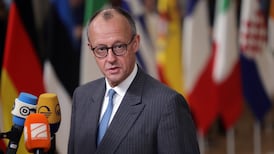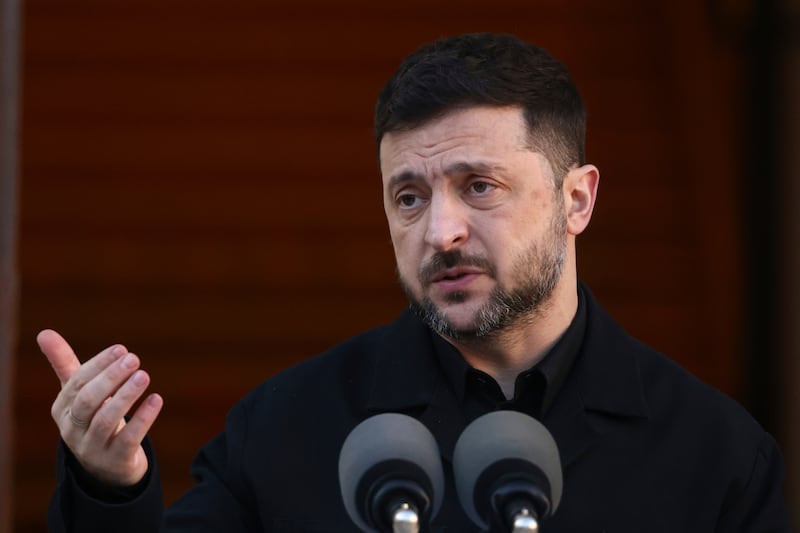The first group of people seeking asylum in the European Union shipped to Albania by Italian authorities were not there for long.
Italian prime minister Giorgia Meloni’s controversial plan to hold thousands of asylum seekers in the Balkan country while their claims were processed was blocked by the courts shortly after the first numbers disembarked in Albania.
The intention was that male asylum seekers from countries deemed “safe”, who were picked up in Italian waters trying to cross the Mediterranean to Europe, would not be taken ashore but instead transported to Albania.
A court in Rome last week ruled the group of about a dozen men, from Egypt and Bangladesh, could not be detained in Albania under the scheme, as their home countries were not considered safe.
READ MORE
The ruling, which saw the men then transported to Italian soil, drew stinging criticism from Meloni’s right-wing government, which is now trying to find a way around the legal hurdle.
[ Albanian parliament ratifies migration centres deal with ItalyOpens in new window ]
Two detention centres have been built in Albania to house 3,000 asylum seekers from Italy at a time. The facilities are considered under Italian jurisdiction, with asylum cases being assessed by Italian officials. Asylum seekers whose claims are successful would be allowed into Italy as refugees; those whose cases are rejected would be deported.
“The government is determined to go ahead, the money invested is already considerable,” says Elisa de Pieri, an Amnesty International researcher focusing on Italy and migration policy. The Albania plan is to be a “symbolic deterrence”, putting migrants off making the sea crossing to Italy, she says.
Amnesty and other civil society organisations have criticised the policy as outsourcing asylum beyond the EU’s borders. The fear is it will result in asylum seekers having trouble accessing legal advice on their case or leave people living in concerning conditions.
Several other EU countries are now looking to the Albania deal as something the bloc could take inspiration from.
[ EU deportation hubs not the same as ‘stupid’ UK Rwanda policy, Simon Harris saysOpens in new window ]
When the leaders of the 27 member states met for a summit in Brussels last week, most were pushing for the EU to take a harder stance on asylum. Leaders spoke one after the other about the pressure their states were under, according to several sources. In particular there was a drive to increase the number of “returns” of failed asylum seeker – another word for deportations.
The Netherlands, Denmark, Austria, Italy, Greece and others earlier this year raised the prospect of setting up deportation hubs outside EU borders. These would be centres in other countries where asylum seekers whose claims were rejected could be sent, while efforts were made to deport them to their home country. European Commission president Ursula von der Leyen recently said the commission would look at the idea.
Chiara Scissa, a University of Bologna postdoctoral researcher on EU law and asylum policy, says that, in the drive for faster decisions on asylum cases, there is a risk people could be sent back to places where they would be at risk. “Returns must be carried out in a way which is absolutely 100 per cent compliant with EU law, human rights law and asylum law… We don’t see that in the current Italy-Albania deal or these hypothetical return hubs,” she says.
The hubs could also be an attempt by EU states to get around obligations they had to asylum seekers, according to Tineke Strik, a Green MEP from the Netherlands. Previously the European Parliament’s lead negotiator on a draft returns law, she says the hub idea is a “worrying” distraction, put forward by politicians who want to seem tough on immigration.
She is critical of the new right-wing Dutch coalition government – which includes the far-right Freedom Party – which has floated a plan to send failed asylum seekers to Uganda. Keeping asylum at the top of the political agenda without really addressing problems in the system suits anti-immigrant parties on the right, Strik says. “It gives me an impression that they want to stay in crisis mode, as it serves their political interests.”
There is a consensus among European politicians, officials and observers that the political centre ground has shifted to the right on migration. “I think what you see over the years, the debate has clearly evolved in one direction,” a senior EU official says. Preventing irregular migration is a stated aim of the EU in black and white in a way that would have been “inconceivable” several years ago, he adds. “The dynamic and the views have changed.”
“The focus is on returns and border control, that is what the EU wants to do, try to reinforce as much as possible the borders, in order to ensure more control over those people who are trying to come into fortress Europe,” says Scissa, the Bologna university researcher.
Speaking recently von der Leyen said she planned to propose new EU legislation on returns. The commission president said only one-fifth of asylum seekers deemed to have no claim to remain in the EU were “returned” to countries outside the bloc at present.
The problem has been that countries asylum seekers came fromoften do not want to co-operate and accept returns. Lena Düpont, a centre-right German MEP with the Christian Democratic Union, says this is a clear “bottleneck” in the system. The EU should leverage offers of more favourable visa schemes, to get buy-in from countries of origin to accept returns, she says.
Even within the EU, there has for years been a lack of agreement to accept transfers of people seeking asylum.
[ EU leaders push for harder stance on asylumOpens in new window ]
Under what is known as the Dublin regulation, asylum seekers should have their claim assessed in the first EU state where they apply for protection. In reality, many keep moving afterwards towards Germany or other western member states. Frontline countries such as Italy or Greece, the points of arrival for those crossing the Mediterranean, don’t object as this relieves some pressure on them. Frustration with this secondary movement was one of the reasons Germany threw up checks on all of its borders.
The number of transfers of people back to the EU state where they first claimed asylum is tiny. In Ireland, for example, just 32 asylum seekers have been transferred to other member states under the Dublin rules since 2020, according to Department of Justice figures.
Those rules are being overhauled in a major EU-wide reform of asylum policy set to come into force by mid-2026. The migration and asylum pact passed into law earlier this year centres on burden sharing to help frontline states. This will see other EU countries agree to take in asylum seekers or pay a financial contribution of €20,000 per person refused to member states who do. The changes will allow for fast-tracked decisions and move more of asylum processing to member states’ borders.
Greece has in recent years already built imposing border facilities, which may become more common under the pact. The “closed controlled access centres” on its Aegean Islands of Kos, Samos and Lesbos have been described as prison-like, with high, barbed-wire topped fences. A Council of Europe report in July said asylum seekers in the centre on Kos were subject to “inhuman and degrading” treatment, as overcrowding left people sleeping on floors without mattresses.
Many national leaders are pushing for parts of the EU migration pact to kick in earlier, as they continue to face pressure from anti-immigrant and far-right parties at home. Some are not waiting for the EU to move as a group. Polish prime minister Donald Tusk recently announced plans to close his country’s border with Belarus to asylum seekers.
[ Poland’s Tusk says he will protect Polish security at EU summitOpens in new window ]
During the recent European Council summit, Tusk argued that Russia and Belarus were bringing migrants from the Middle East and Africa and pushing them over their borders into the EU. The practice was an attempt to use migration to strain European democracies, in a hybrid front of Russia’s war in Ukraine, Tusk reportedly told leaders.
There was a sense in the room that Poland should be given leeway to block people crossing its eastern border from claiming asylum, according to several sources briefed on the discussion. The fact there was no real protest or pushback against the move was another clear indication that asylum policy in Europe is going in one direction – to the right.
- Sign up for push alerts and have the best news, analysis and comment delivered directly to your phone
- Find The Irish Times on WhatsApp and stay up to date
- Our In The News podcast is now published daily - Find the latest episode here




















